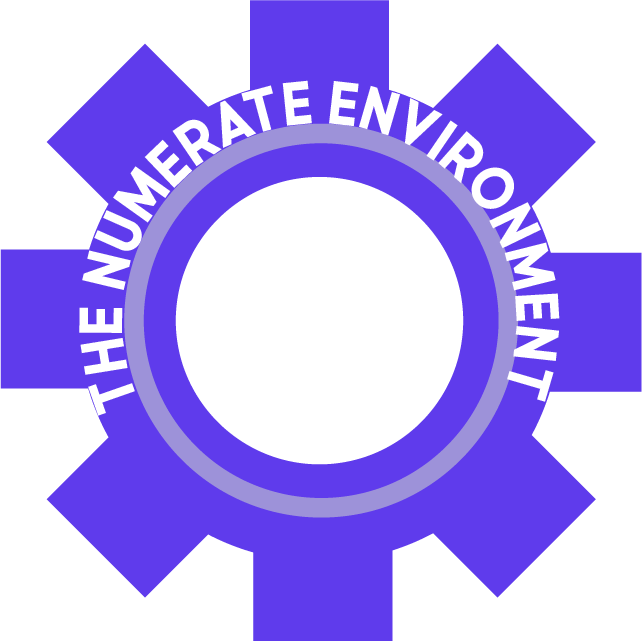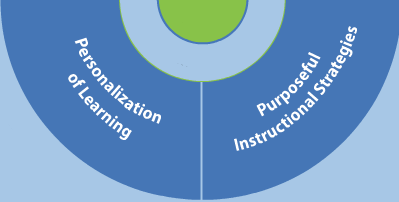
Numerate Environment
Rich Tasks Promote Reasoning and Problem Solving
What does this mean?
Not all tasks provide the same opportunities for student thinking and learning (Hiebert & Grouws, 2007), SanGiovanni, 2015). Student learning is greatest in classrooms where the tasks consistently encourage high-level student thinking and reasoning and least in classrooms where the tasks are routinely procedural in nature
(SanGiovanni, 2015).

Criteria for Rich Tasks
The folllowing table is from SanGiovanni, 2015.

How do I Support This?
CONSIDER
Rethinking how we have students solve word problems
For Example:
- Ask students to compare two problems with different scenarios but the same mathematical structure. Discuss the differences and similarities between the two, noting that the scenario can be changed while leaving the underlying mathematical structure and calculations unchanged.
- Ask students to compose word problems for a given mathematical calculation (e.g., 30 ÷ 5 = 6). Compare the different problems and their solutions, and discuss the different ways in which the underlying mathematical structure is represented in words (e.g. grammar, syntax, vocabulary.)
- Give students opportunities to practise mathematizing word problems; ask them to rewrite the problem or or change the mathematical operation required.

- Discuss the language used in students’ word problems and how that language relates to the underlying mathematical task.
- Invite students to revise a given word problem to make it more comprehensible or more realistic. For example, given a word problem set in a shopping scenario, students could research current prices and update the problem accordingly.
- Ask students to compose and solve word problems relating to recent events in their lives, such as a trip, shopping expedition, or hockey game. It is important that these events be elicited from students.
- Invite students to engage with problem contexts by extending them in different ways (e.g, given a problem about a garden design, ask students to create a picture of the garden; given a problem about a school trip, ask students to prepare a short drama scene or write a story about what happened on the trip).
(Examples taken from Barwell, 2011, p. 4; Geiger 2016)
Create Low Floor, High Ceiling Tasks
- Creating tasks that are challenging yet accessible to all students. Tasks must feel achievable to students. These tasks are called Low Floor, High Ceiling tasks. Everyone in a group can begin and then work at the task at their own level .
Using a Range of Strategies
- Requiring all students to have a range of strategies and approaches from which to choose in solving problems, including but not limited to, general methods, standards algorithms, and procedures (SanGiovanni, 2015).
Modeling Thinking Strategies
- Providing rich math tasks along with scaffolded instruction, explicitly modeling thinking strategies and encouraging students to self monitor and self question as they work through the tasks (Henningsen & Stein, 1997).
- Using Number Talks to develop computational fluency.
Integrating Math Planning
- Integrating mathematics into the study of other content areas or use other subjects as the context to teach mathematics (e.g. health and nutrition) in order to help students apply mathematical concepts to everyday life (Carraway et. al, 2015).
Teacher Professional Learning Resources
Resources to use with your Class and Students:
Bibliography and Further Reading
Barwell, R. (2011, June). Word Problems Connecting language, mathematics and life . The Literacy and Numeracy Secretariat. Retrieved from http://www.edu.gov.on.ca/eng/literacynumeracy/inspire/research/WW_Word_Problems.pdf
Carraway-Stage V, Roseno A, Hodges CD, Hovland J, Diaz S, Duffrin MW. (2015). Implementation of a Food-Based Science Curriculum Improves Fourth-Grade Educators’ Self-efficacy for Teaching Nutrition. Am J Health Educ. 2016;47(3):155–162. Available at: https://www.ncbi.nlm.nih.gov/pmc/articles/PMC4610394/ [Accessed 28 Oct. 2019].
Geiger, V. (2016). Teachers as designers of effective numeracy tasks. In Proceedings of the 39th Annual conference of the Mathematics Education Research group of Australia (pp. 254–261). Retrieved from https://www.researchgate.net/publication/307594086_Teachers_as_designers_of_effective_numeracy_tasks
Hiebert, J., & Grouws, D. A. (2007). The effects of classroom mathematics teaching on students’ learning. In F. K. Lester (Ed.), Second handbook of research on mathematics teaching and learning (pp. 371–404). Charlotte, NC: Information Age Publishers.
Henningsen, M. and Stein, M. (1997). Mathematical Tasks and Student Cognition: Classroom-Based Factors That Support and Inhibit High-Level Mathematical Thinking and Reasoning. Journal for Research in Mathematics Education, [online] 28(5), p.524. Available at: https://pdfs.semanticscholar.org/b361/6293dd5afbbd6b4a58aee58dc6888aa33b73.pdf [Accessed 28 Sep. 2019].
SanGiovanni, J. (2015). Rich Tasks and productive struggle: Effective teaching with principles to action institute. NCTM. https://www.nctm.org/uploadedFiles/Conferences_and_Professional_Development/Institues/Pre-K_Grade_12_Common_Core_Series/Beth_presentations.pdf



